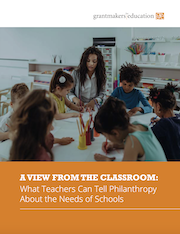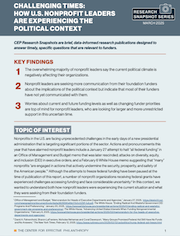Site Search
- resource provided by the Forum Network Knowledgebase.
Search Tip: Search with " " to find exact matches.
"Co-Creation" is a case study about the Connecticut Early Childhood Funder Collaborative, a project of the Connecticut Council for Philanthropy. The case study, written by Patricia Bowie, examines co-creation, an emerging systems change collaboration model which grew out of a funder-and-state partnership. This unique partnership led to the creation by executive order of a new and independent Office of Early Childhood, which was formally approved by the Connecticut State Legislature in 2013. The companion piece, "Taking on New Roles to Address 21st Century Problems," looks at co-creation from the perspective of a regional association of grantmakers.
The Connecticut Early Childhood Funder Collaborative comprises 14 funders from around the state who bring many years of experience in supporting and operating programs that serve the needs of children and families.
Join Grantmakers Concerned with Immigrants and Refugees (GCIR) for a conversation with Norma on visionary strategy, collective practice, and what leaps we need to make in a time of maximum fear.
In her book, When No Thing Works: A Zen and Indigenous Perspective on Resilience, Shared Purpose, and Leadership in the Timeplace of Collapse, Zen master and Indigenous Hawaiian leader Norma Wong describes this time as an era of collective acceleration, where the swiftly moving current, fed and shaped by human actions, sweeps us toward ever uncertain futures. In her book and in her work, Norma invites us not only to imagine, but to live into, a story beyond crisis and collapse.
Registration:
There is no cost for this webinar.
You will need to log in or create an account on GCIR's website to register for this program.

“A Time for Action: Mobilizing Philanthropic Support for Boys and Young Men of Color” lays out a vision and a bold plan of action to maximize the potential of philanthropy and the private sector to increase opportunity for boys and young men of color that benefits the entire country. While it focuses on systems, policies, and practices that profoundly shape the lives of our sons and brothers, the recommended actions also help to create the conditions for all children and young adults to thrive, regardless of race, ethnicity or gender. The plan is bolstered by $194 million in initial investments in key initiatives, including for example programs to enhance school learning environments and reduce the overrepresentation of young people in the justice system.

CEP surveyed a nationally representative sample of nonprofit leaders to understand how nonprofits are experiencing the rapid shifts in policy from the new presidential administration and the current political climate.
In this new monograph, Philanthropy Northwest board member Daniel Kemmis explores the sometimes-fraught relationship between philanthropy and democracy. Beginning with a wide-ranging stroll through the shared history of philanthropy and democracy, Kemmis examines the current post-Citizens United landscape and asks whether philanthropy can and should do more to strengthen the infrastructure and practices of democracy.
The Silicon Valley Out-of-School-Time Collaborative invested in a cohort of regional nonprofit organizations to sustain and strengthen their ability to serve more students with stronger academic and social-emotional programming. Partners in the collaborative included three family foundations that together made an initial $1.6 million pooled investment over three years, and eight nonprofits that collectively served more than 7,000 low-income middle and high school students outside normal school hours. From the start of the partnership, funders and grantees held regular meetings focused on shared learning, trust building and dialogue. A midcourse evaluation of the collaborative showed that grantees were stronger, programs were better and are reaching more students, and funders had adopted new, collaborative grantmaking practices. The funders invested another $900,000 into a second phase of the work and committed to more flexibility –– letting grantees drive the group’s planning and learning efforts, and manage consultants, budgeting and group communications. Grantees also opted to redirect the focus of the collaborative from capacity building to program development and evaluation, with the added goal of sharing effective afterschool and summer program models with others, both inside and outside the region.
BD contacted the Corporate listserve to ask questions to benchmark Community Service/Volunteer Paid Time Off Policy & Internal Company Guidelines for Volunteer Councils. They are formalizing some of their programs and wanted to see what other companies are doing.
Community Service/Volunteer Paid Time Off Program – BD allows US employees 2 days off for personal volunteer time with several restrictions on organization types. We have guidelines but no formal policy. Currently we don’t track participation or hours. To help us, please answer the following questions:
Do you have a Community Service/Volunteer Paid Time Off Policy/Program? If so:
- How many paid days off per year are given to employees?
- Is your program limited to just US employees or are International employees included?
- Are there any limitations to the types of volunteer projects/organizations that are acceptable?
- Is the time off limited to company-sponsored projects or is it open to individual employee volunteer experiences?
- Is manager approval required and if so, how is this tracked?
- How do you track the volunteer hours?
- Does the policy fall under the responsibility to Human Resources or Corporate Social Responsibility?
- Would you be willing to share your policy please?
Company Employee Volunteer Councils – BD has groups of employees at most of our sites who organize volunteer projects for local employees to participate in. We call these groups Volunteer Councils. We do not have any written guidelines for the Volunteer Councils but feel this would be helpful especially in reporting outcomes to our Corporate Social Impact Team. To help us, please answer the following questions:
Do you have Volunteer Councils who coordinate and manage volunteer activities for your site locations? If so:
- Do you have guidelines on how these Volunteer Councils should operate?
- Are there any restrictions on the type of volunteer projects that associates can manage on behalf of the company?
- Do you provide any Corporate grant dollars for the Volunteer Councils to use to support their nonprofit partners?
- Would you be willing to share your guidelines please?
Responses came from 17 corporations from the CNJG community and other corporate giving programs from different areas of the country.
Native Voices Rising is a joint research and re-granting project of Native Americans in Philanthropy and Common Counsel Foundation. This report focuses on the practices and challenges of community organizing and advocacy, focusing on the need for increased investment in and sustained support for American Indian, Alaska Native and Native Hawaiian communities.
Learn how you can register for events online, search the member directory for organizations and colleagues who have the same interests, and update your profile.
A CNJG member queried our listserves for sample questions (not included in the grant application) you might ask grantees or potential grantees during site visits. CNJG compiled these responses, and other documents members use.
Sample disaster preparedness and recovery plans for foundations.
Sample bylaws for Community Foundations.
Philanthropic organizations of all shapes and sizes are well positioned to support Communities for a Lifetime (CfaL). This issue brief explores four roles for philanthropy in advancing CfaL work.
